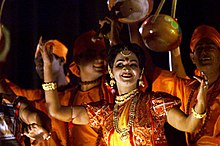Kavigan
| Music of Bangladesh | |
|---|---|

|
|
| Genres | |
| Specific forms | |
| Religious music | |
| Ethnic music | |
| Traditional music | |
| Media and performance | |
| Music awards | |
| Music festivals | |
| Music media |
Radio Television Internet |
| Nationalistic and patriotic songs | |
| National anthem | Amar Sonar Bangla |
| Other |
Notuner Gaan (National March) Ekusher Gaan (Ode to the Language Movement) |
| Regional music | |
| Related areas | |
| Other regions | |
Radio
Television
Internet
Kavigan (Bengali: কবিগান) is a form of Bengali folk performance wherein folk poets sing and perform.
Kavigan is normally sung by two groups. Each group is led by a kaviyal or sarkar. The accompanying singers called dohars often repeat what the leader said. A kavigan programme starts with bandana (evocation) or gurudever geet (song of the sect patron). The bandana can be directed to or be in praise of Saraswati, Ganesh, people, and the audience, as deemed fit by a particular kaviyal. This is followed by Radha–Krishna related song, some call it agamani. Then songs on four subjects are sung: Sakhi sambad, biraha, lahar and kheur.Sakhi Sambad deals with the love-songs related to Radha-Krishna. Biraha is about the mortal pang of separation of common human beings. Kheur is mainly about gods and goddesses, but often includes mild slangs. Finally, the competitive part starts. It mainly consists of the Lahar, where the competitors personally attack each other, musico-verbally. In kavigan, also referred to as kabir larai, two person who are lyricist plus composer at the same time answer each other in form of songs.
In his Banglar Kavigan, Sajani Kanta Das said, "Kavigan was born out of a synthesis of various art forms prevalent in different parts of Bengal at different times having peculiar names such as tarja, panchali, kheur, akhrai, half akhrai, full akhrai, danra kavigan, basa kavigan, dhap kirtan, tappa, Krishna jatra, tukkagiti etc." Various literary researchers such as Ishwar Chandra Gupta and Dr. Harekrishna Mukhopadhyay have dwelt at length on the origins and development of kavigan.
Dr. Sushil Kumar Dey opines, "The existence of kabi songs may be traced to the beginning of the 18th century or even beyond it to the 17th; but the flourishing period of the Kabiwalas was between 1760 and 1830." As the religious and ritualistic content in Bengali poetry wore out there was a tendency to break away from the traditional Vaishnava poetry but the real breakthrough came only with the introduction of the printing press in mid–18th century. From the close of the 18th century for more than half a century the new kavi–poetry and panchali reigned supreme in the Kolkata region and almost threatened to sweep everything else in literature. However, while Kavigan lost its supremacy in Kolkata, it retained its position in rural Bengal.
...
Wikipedia
